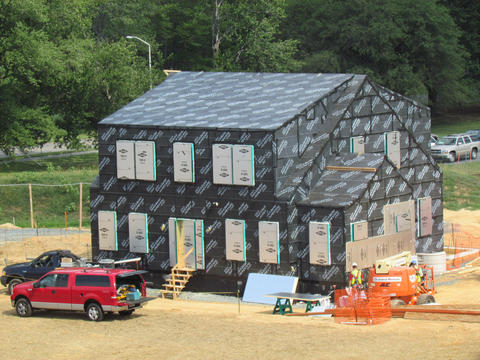
During construction, NIST's net-zero energy house was wrapped in a continuous membrane to seal out air and moisture, which greatly reduced heating and cooling loads. But nearly eliminating unintended air infiltration required NIST to take deliberate steps to achieve a high quality indoor environment.
You can breathe easy in the net-zero energy house at the National Institute of Standards and Technology (NIST). After 15 months of monitoring, researchers report that even with its airtight construction, air quality inside the two-story house-cum-laboratory bests the air quality in new, conventionally built houses.
The new study of the unfurnished house finds that through careful design and selection of materials, the institute's Net-Zero Energy Residential Test Facility (NZERTF) meets the twin, yet sometimes conflicting goals of energy efficiency and indoor air quality. Previous experience has shown that focusing on only one can come at the cost of the other, unless both goals are addressed thoughtfully.
A net-zero energy home—one that produces at least as much energy as it uses in a year—should not compromise the quality of indoor air. A key step to achieving the efficiency is to, in effect, shrink wrap the structure, sealing off outside air to minimize energy use for cooling or heating. But without mechanical ventilation, indoor air is trapped, since very little outside air can seep in through almost nonexistent cracks or other openings. As a result, contaminants emitted by paint, plywood and other indoor materials and products can accumulate over time.
Emissions of formaldehyde, a carcinogen and irritant associated with asthma and other ailments, inside the NZERTF were 23 percent below typical values reported in other studies of houses, the researchers found. (Currently, there are no national regulatory limits on indoor formaldehyde in homes.) The NIST team also measured levels of 30 other volatile organic compounds (VOCs)—gases emitted by a variety of building materials. All were found to be "generally less" than levels reported in previous studies of new site-built and manufactured houses.
The researchers attribute this dual success to the use of low VOC-emitting products and materials during construction and installation of a mechanical ventilation system that complied with the residential indoor air quality standard published by the American Society of Heating, Refrigerating and Air-Conditioning Engineers.
"A variety of net-zero energy buildings have been built and the number is growing," says NIST environmental engineer Dustin Poppendieck, "but it remains a challenge to ensure that indoor conditions are healthy and comfortable for the occupants. Our study of the NZERTF demonstrates the effectiveness of one approach to achieving a high-quality indoor environment in a net-zero home."
Applying their findings and lessons learned during the NZERTF's design and construction, the team collaborated with outside experts to write High Performance Indoor Air Quality Specification for Net Zero Energy Homes.** Intended for architects, builders and contractors, the customizable guidance distills a largely nonprescriptive, performance-based approach for selecting or specifying systems and products to achieve indoor air quality goals.
The NZERTF monitoring study shows that energy efficiency and indoor air quality goals are not incompatible. Over its first year, the house's solar panels produced more energy than consumed by the structure and its simulated family of four—thanks, in large part, to the NZERTF's heavily insulated, airtight building envelope, which significantly reduces heating and cooling loads. But even though infiltration of outside air was blocked almost entirely, levels of formaldehyde and 25 of 30 other VOCs that the team tracked were consistently below levels in new homes reported in other studies, thanks to air quality considerations in the NZERTF's design and construction.
"In energy-efficient houses with almost no uncontrolled infiltration of outside air," says Poppendieck, "effective control of air pollutants generated indoors requires reliable mechanical ventilation systems that are operated at recommended rates."
D.G. Poppendieck, L.C. Ng, A.K. Persily and A.T. Hodgson, Long Term Air Quality Monitoring in a Net-Zero Energy Residence Designed with Low Emitting Interior Products, Building and Environment (2015), doi: 10.1016/j.buildenv.2015.07.001.
** Berkeley Analytical Associates, Bernheim + Dean Inc, White + GreenSpec, High Performance Indoor Air Quality Specification for Net Zero Energy Homes (2015), NIST GCR 14-980. Download at: http://nvlpubs.nist.gov/nistpubs/gcr/2015/NIST.GCR.14-980.pdf.

